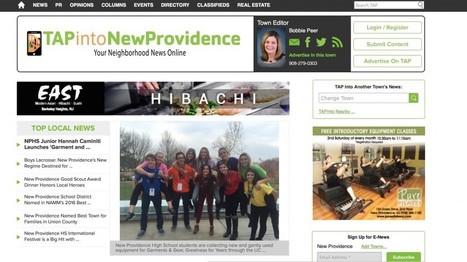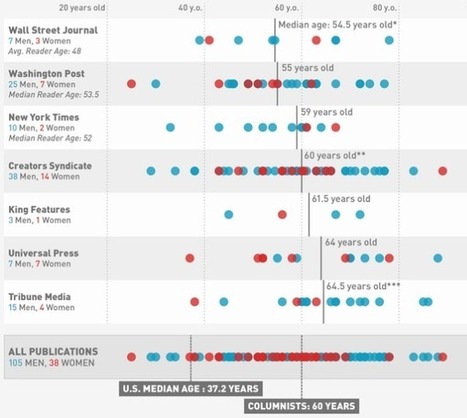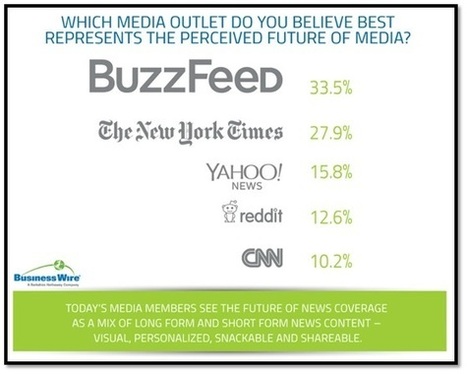 Your new post is loading...
 Your new post is loading...
Six years ago, at a high school event in suburban New Jersey, Michael Shapiro was covering the story for a hyper-local news site he had founded two years earlier when he spotted a journalist from an established local print newspaper from the same town. “I extended my hand to shake hers,” he recalls, “and she turned around and walked away. People who saw it, their eyes opened wide. They couldn’t believe it.” Those were the early days of Shapiro’s foray into hyper-local news. He was a former lawyer who was building a network of websites covering towns in New Jersey, and some of the state’s old-guard journalists, didn’t like it. Getting the cold shoulder from them, he says, was not unusual. “They saw us as a threat,” says Shapiro. “It was also a matter of, ‘ Who are you to come into my town,’ as if it’s their town.” But things have changed considerably since then. Now, Shapiro presides over a rapidly expanding network of 51 hyper-local franchises dotted throughout New Jersey and, more recently, New York state. (Two more just signed on and will launch this spring. A brief expansion into Pennsylvania failed.)...
The fast pace of the modern lifestyle—born from high-speed, hand-held, wireless connectivity—has not only changed the way we send, receive, and consume information, but has transformed the way journalists operate. This has led some of them to make a concerted effort to slow down and take a different tack.
“Slow Journalism is deep journalism—journalism that is informed by deep immersion in the story at ground level,” explains National Geographic Fellow Paul Salopek.
Salopek is conducting an experiment in this modern expression of a timeless human pursuit. He’s engaging with major stories of our time at the natural speed of his own footsteps as he retraces our ancestors’ migration from Africa to South America with his Out of Eden Walk. Along the way he’s not just looking for the latest news updates, he’s revealing the texture of the lives of people he encounters: nomads, villagers, traders, farmers, and fisherman who live within front-page stories, but normally don’t make the news themselves....
The New York Times Innovation Report has been ripped to pieces by many brains in the media world but the issues are the familiar TBD framework I work with, namely Technology (can/does it do what is needed?), Behaviour (will people do what we need/want?) and Data (will enough people do what we need?).
After ploughing through it, despite a slightly depressing overtone, I am confident the New York Times will pull through…the industry can’t afford it not to (read: have an R&D budget). The very fact it is doing a report of this sort (especially considering who asked for it) means they are focusing and clear about their future problems – success therefore is predicated on hard decisions being made about some very core issues (staff etc).
A few things stood out when I read the report...
Journalists have to simplify material for a general audience. Is there a technological fix?Scientists and the journalists who cover them are locked in an “eternal tug of war,” Sabine Hossenfelder writes. The journos feel they have to elide detail so a general audience can read them. The scientists feel the resulting “knowledge transfer” to readers is pitifully low. Hossenfelder illustrates the problem with a series of graphs, like this one...
I love the NYT, it has always been one of my favorite publications I've read daily since I was a kid. However this opinion piece on marijuana reform is without question the single worst thing I think I've ever read on the site.
...Clearly many of these people are out of touch with our culture. Opinions of those stuck in their ways, afraid of change and in no way reflecting reality. But it isn’t just age. You can be old and informed on issues and present a balanced opinion.
This is another reason many bloggers have risen so quickly: their words resonate with what’s actually going on. If you have opinions, it’s still a huge opportunity for you to balance those from an alarmist, afraid, homophobic, intolerant and increasingly irrelevant era.
Forget the digital doomsayers, said Jill Abramson. “Long-form narrative is not only alive but dancing to new music.”Other prominent journalists echoed The New York Times managing editor’s optimism about thriving in a Twitter age at Boston University’s annual narrative journalism conference last weekend.Abramson said devices like tablets and iPads give long-form narrative new ways to reach new audiences.
She said her paper focuses on integrated storytelling in series like “A Year At War,” with multimedia “freshening” the story by letting readers “see, feel and almost taste” soldiers’ and families’ experiences.She added that new tools can’t trump journalism basics. Wary of “narrow specialists,” she worries that journalism schools’ new technology training may detract from traditional shoe leather reporting values....
|
Business Wire’s 2015 Media Survey is now available and it offers startling results about how journalists see the future of news media. The landscape of media is changing – new platforms and new styles. The New York Times is an institution but it didn’t start off as one. How will we be referring to BuzzFeed decades from now? Will the two seemingly different lines of media style intersect at some point in the future? These questions are part of the debate regarding the future of media and journalists are split.
According to an article published in The Guardian back in 2013, BuzzFeed is described as an, “irreverent US news and entertainment website taking the social web by storm” and investor Kazz Lazerow, co-founder of Buddy Media, described the website as “the defining media company for the social age.”
Only a few years ago, BuzzFeed represented the wave of change the digital age brought upon news media and that wave has only continued to grow. Now, BuzzFeed is challenging traditional forms of news, jockeying to become the standard of journalism.
When asked to decide between The New York Times style and the BuzzFeed style, journalists made clear that while the classical form isn’t going anywhere, it will have to share its place at the top....
In the last few weeks the shooting down of Malaysia Airlines Flight 17, the Ukrainian crisis and the situation in the Gaza Strip are monopolizing media attention....
Last Wednesday the Twitter account of the Associated Press posted this tweet: BREAKING: Dutch military plane carrying bodies from Malaysia Airlines Flight 17 crash lands in Eindhoven.
The news was verified, the tweet was not wrong from a grammatical point of view, however there was an ambiguity whereby if the word 'crash' is read as a part of the verb 'crashland' rather than as a noun, the meaning becomes the plane which was carrying the bodies of the passengers of the MH17 had crashed. A little later, the account clarified the misunderstanding, but the damage was done with the tweet wrongly interpreted and already shared by thousands of people, sparking the most varied reactions.
The episode has prompted Megan Garber of The Atlantic to write a piece about the use of "breaking news" designation. According to Garber, it was not a necessary piece of news to add to many others re-launched as indispensable 'breaking news' (a plane has landed, after all: it is news in an article, in a context, but not breaking news itself). It is useless to engulf the news ecosystem. "The term 'breaking' is quickly losing its meaning," Garber explains, in agreement with what Felix Salmon stated during the last edition of the International Journalism Festival....
There are those who proclaim the rise of digital media is finally giving way to a “golden age of journalism.” And then there are the pessimists who see little but doom or gloom.
And, to be fair, there’s ample evidence for each view. Just check out the Pew Research Center’s 11th annual State of the News Media report that’s being issued today. This year’s study goes in-depth into the revenue picture for news, the rise of digital reporting and growth of digital video. In many ways, this is the best of times and the worst of times for the industry.
You can read the full report at the Pew website or check out a few handy charts here. Meanwhile here’s the speed-read version....
Caroline Little, CEO CEO of the Newspaper Association of America (NAA), says despite what cynics say, the future of newspapers is bright. In an article published Friday, she shared some NAA research:
"Our audience has grown with the shifting digital landscape, and we’re seeing increased levels of audience engagement and new avenues of consumption. We made the first gain in circulation revenue since 2003, with revenue rising by 5 percent — from $10 billion to $10.5 billion — as digital subscriptions grew dramatically.
The number of unique visitors engaged with U.S. newspaper digital content hit a new high in September 2013, totaling 141 million adults — an impressive increase of 11 percent since just June. We’ve changed with the times to fit the needs of our audience, from print to website to tablet to mobile, adapting our content and strategies for delivery. And it’s working. Across all digital platforms, 71 percent of adults in this country engage with newspaper content, and 55 percent of those visitors consume newspaper content on mobile devices"....
... However, it would be a mistake to think that just because it’s easier than ever to produce amazing digital editorial experiences that this makes organisational change easy. It takes an entirely different set of skills to get buy-in from stakeholders or to Jedi mind trick the empire builders of senior management. It is hard, and even I underestimated the size and nature of the challenge as I transitioned from young digital maverick field journalist to digital editor in the middle of the last decade.
While a lot is different in 2013 than it was in 1996 when I started in digital journalism, or even than it was five or six years ago, change still is hard. In some ways, it is even harder now as most newspapers struggle with redeploying diminishing resources carefully from the core business to new digital initiatives. The politics are fierce. Even when it is in an organisation’s best interest, even when it is an organisation’s stated interest to embrace digital, winning the political and cultural battles is hard, thankless work. I know people who stayed and fought these battles inside organisations, and I have deep respect for them and learn from them whenever possible. When I return to working for an organisation, hopefully soon, I will take lessons that I’ve learned from these friends....
|



 Your new post is loading...
Your new post is loading...


















Hyperllocal news is thriving with TAPinto. Good story.